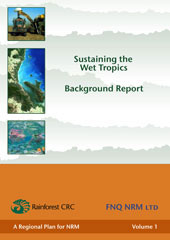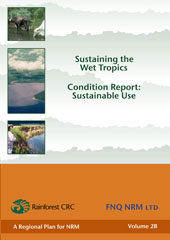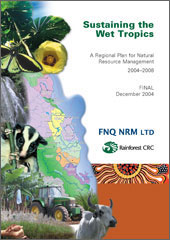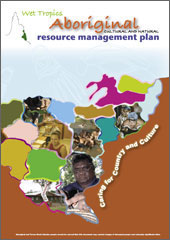 |
||||
 |
Back to Publications / Back to Home Page On this page: Wet Tropics NRM Series / Wet Tropics Aboriginal Cultural and Natural Resource Management / The Wet Tropics NRM Planning Region - A History Wet Tropics NRM Series In 2005, researchers of Project 1.1, with the assistance of many scientists, industry representatives and community members, finalised the accredited publications Sustaining the Wet Tropics: A Regional Plan for Natural Resource Management 2004-2008, published in conjunction with FNQ NRM Ltd, the community-based Natural Resource Management (NRM) Board for the Wet Tropics. The Plan, as part of the Federal Government's requirements for all regional NRM bodies across Australia, strategically focuses regional investment to manage the natural resources and cultural values of the Wet Tropics in a sustainable manner, and incorporates management plans already in place. The Plan will also provide information for policy makers, landowners and the general community about current issues facing the Wet Tropics community and the possible actions to be taken. Three supporting documents were prepared in 2004 to support the overall regional NRM plan. These documents, along with the Regional NRM Plan, are available for download (PDF files) by selecting the thumbnails below. Further detailed information about the Wet Tropics Regional NRM Plan can be accessed at the FNQ NRM Ltd website. |
|||
|
Volume 1 Background Report |
Volume 2A Condition Report: Biodiversity Conservation |
Volume 2B Condition Report: Sustainable Use |
Regional NRM Plan |
|
| Back
to top Wet Tropics Aboriginal Cultural and Natural Resource Management Plan |
||||
In response to the aspirations of Traditional Owners of the Wet Tropics NRM region, it was recognised that a document outlining their cultural and natural resource management requirements and priorities should form part of the overall regional plan for NRM investment. In September 2004, following a three-year community engagement and write-up phase, a draft 'Aboriginal Plan' and summary was sent to Traditional Owners and key organisations throughout the Wet Tropics region seeking feedback and submissions from individuals, groups and organisations. A series of workshops were conducted between October and November 2004 throughout northern Queensland to enable Traditional Owners to discuss the draft plan and allow for further development. In March 2005, a one-day workshop held in Cairns saw the Traditional Owner Advisory Committee's endorsement of a draft Aboriginal Plan, summary poster, CD-ROM, DVD and website. Caring for Country and Culture: The Wet Tropics Aboriginal Cultural and Natural Resource Management Plan ('The Aboriginal Plan') was officially launched on 29 April 2005 in Innisfail, north Queensland, in conjunction with the launch of the Wet Tropics World Heritage Area Regional Agreement, by Traditional Owners, FNQ NRM Ltd and the Rainforest CRC. |
||||
|
'The Aboriginal Plan' |
||||
The Aboriginal Plan takes a different approach to other NRM plans in that it focuses on social, cultural and economic dimensions of NRM. It is a blueprint that outlines a clear way forward for all levels of government and the broader community to develop equitable partnerships with Aboriginal peoples to address a wide range of social, cultural, environmental and economic issues. The Aboriginal Plan raises national awareness of the pivotal role Traditional Owners play in the ecologically sustainable development of northern Australia and aims to increase opportunities for and involvement of Indigenous peoples in local and regional resource management. Download The Aboriginal Plan by clicking on the thumbnail (above right). The Plan was also issued with an accompanying poster and CD-ROM. Copies of the poster and CD-ROM may be requested by contacting FNQ NRM Ltd. See also Developing the Wet Tropics Aboriginal Cultural and Natural Resource Management Plan Download Fact Sheet Background to the Wet Tropics Aboriginal Plan |
||||
 |
||||
| Back
to top The Wet Tropics NRM Planning Region - A History |
||||
In August 2001, two organisations with a major interest in natural resource management in the Wet Tropics region, the Natural Resource Management Board (Wet Tropics) Inc. (NRM Board) and the North Queensland Afforestation Association (NQAA), held a forum which resolved to prepare a new regional natural resource management plan (NRM plan). This plan would build on existing studies and conform to new State and Commonwealth requirements for such work. It would also give regional direction to future funding and prioritise investment from a range of sources, most notably Phase 2 of the Natural Heritage Trust. Principles Behind the New Plan One of the advantages of designing a new NRM plan for the Wet Tropics included using the available, but limited, resources strategically to get the most benefit for the Wet Tropics region. In the past, support for community-based programs had been criticised as being ad hoc and not necessarily focussed on key NRM priorities. Changes in NRM policy addressed these and other criticisms by promoting strategic investment at a regional scale over the old project-based approach. Consequently, future funding would revolve around regional NRM plans that: |
||||
|
||||
| In order to attract funding, the Wet Tropics Regional NRM Plan would need to be accredited by State and Commonwealth governments. | ||||
Scope of the Plan Key topics to be addressed in the plan included: |
||||
|
||||
Developing the Plan |
||||
Research of Program 1 of the Rainforet CRC and the regional NRM organisation (FNQ NRM Ltd) prepared the new plan. The CRC, local government and State and Commonwealth agencies in the Wet Tropics region funded the project jointly. A Joint Working Group, comprising representatives from the NRM Board, NQAA and traditional landowners, is overseeing the project. A Key Stakeholder Reference Group of government, industry and community representatives has been formed, alongside an Indigenous Working Group. A Regional Science Panel has also been convened to provide specialist input into the project. The outputs of the project to be provided by July 2003 included: |
||||
|
||||
| Back to top | ||||
 |
||||




